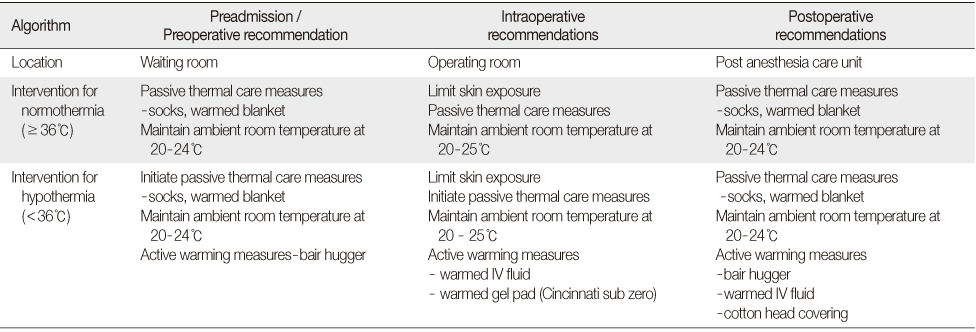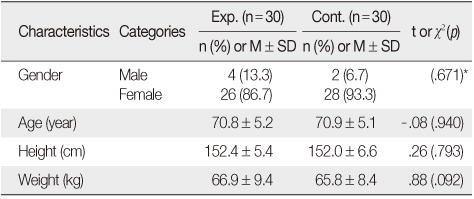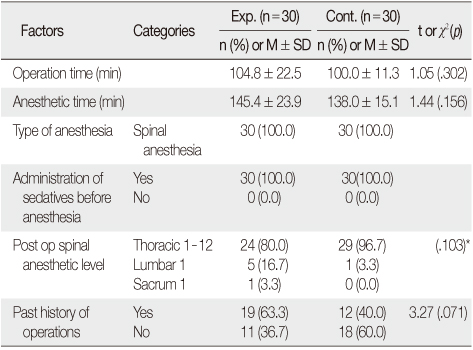Articles
- Page Path
- HOME > J Korean Acad Nurs > Volume 43(3); 2013 > Article
-
Original Article
- Effects of ASPAN's Evidence-based Clinical Practice Guidelines for Promotion of Hypothermia of Patients with Total Knee Replacement Arthroplasty
- Je Bog Yoo, Hyun Ju Park, Ji Yeoun Chae, Eun Ju Lee, Yoo Jung Shin, Justin Sangwook Ko, Nam Cho Kim
-
Journal of Korean Academy of Nursing 2013;43(3):352-360.
DOI: https://doi.org/10.4040/jkan.2013.43.3.352
Published online: June 28, 2013
1Post Anesthetic Care Unit, Samsung Medical Center, Seoul, Korea.
2Operating Room, Samsung Medical Center, Seoul, Korea.
3Department of Anesthesiology & Pain Medicine, Samsung Medical Center, Sungkyunkwan University School of Medicine, Seoul, Korea.
4College of Nursing, The Catholic University of Korea, Seoul, Korea.
- Address reprint requests to: Kim, Nam Cho. College of Nursing, The Catholic University of Korea, 505 Seocho-gu, Banpo-dong, Seoul 137-701, Korea. Tel: +82-2- 2258-7405, Fax: +82-2-2258-7772, kncpjo@catholic.ac.kr
© 2013 Korean Society of Nursing Science
Abstract
-
Purpose
- In this study an examination was done of the effects of the American Society of PeriAnesthesia Nurses (ASPAN) Evidence-Based Clinical Practice Guidelines on body temperature, shivering, thermal discomfort, and time to achieve normothermia in patients undergoing total knee replacement arthroplasty (TKRA) under spinal anesthesia.
-
Methods
- This study was an experimental study with a randomized controlled trial design. Participants (n=60) were patients who underwent TKRA between December 2011 and March 2012. Experimental group (n=30) received active and passive warming measures as described in the ASPAN's guidelines. Control group (n=30) received traditional care. Body temperature, shivering, thermal discomfort, time to achieve normothermia were measured in both groups at 30 minute intervals.
-
Results
- Experimental group had slightly higher body temperature compared to control group (p=.002). Thermal discomfort was higher in the experimental group before surgery but higher in the control group after surgery (p=.034). It decreased after surgery (p=.041) in both groups. Time to achieve normothermia was shorter in the experimental group (p=.010).
-
Conclusion
- ASPAN's guidelines provide guidance on measuring patient body temperature at regular intervals and on individualized and differentiated hypothermia management which can be very useful in nursing care, particularly in protecting patient safety and improving quality of nursing.
- 1. Choi KH. Comparison of the effects of warming methods on body temperature change, shivering, and post-anesthesia recovery in a recovery room. Busan, Dongeui University. 2007;Unpublshed master's thesis.
- 2. Cohen J. Statistical power analysis for the behavior science. Hillsdale, NJ: Lawrence Erlbaum; 1988.
- 3. Collins VJ. Temperature regulation and heat problem. In: Collins VJ, editor. Physiologic and pharmacologic bases of anesthesia. Baltimore, NJ: Williams & Wilkins; 1996. p. 316–339.
- 4. Cooper S. Home study program The effect of preoperative warming on patients' postoperative temperatures. AORN J. 2006;83(5):1073–1076. 1079–1084. quiz 1085-8.PubMed
- 5. Frank SM, Raja SN, Bulcao C, Goldstein DS. Age-related thermoregulatory differences during core cooling in humans. Am J Physiol Regul Integr Comp Physiol. 2000;279(1):R349–R354.ArticlePubMed
- 6. Gonzalez ER. Guidelines for cardiopulmonary resuscitation and emergency cardiac care. Clin Pharm. 1987;6(2):165–166.PubMed
- 7. Hooper VD, Chard R, Clifford T, Fetzer S, Fossum S, Godden B, et al. ASPAN's evidence-based clinical practice guideline for the promotion of perioperative normothermia: Second edition. J Perianesth Nurs. 2010;25(6):346–365. http://dx.doi.org/10.1016/j.jopan.2010.10.006PubMed
- 8. Jung HM, Kim MH. Effects of a warmed blanket for the relieving of cold discomfort after cesarean section. J Korean Acad Fundam Nurs. 2000;7(1):16–29.
- 9. Kiekkas P, Karga M. Prewarming: Preventing intraoperative hypothermia. Br J Perioper Nurs. 2005;15(10):444446–447. 449–451.ArticlePubMedPDF
- 10. Kim JO, Chung Y, Park YJ. The effects of warming methods on the anxiety and cold discomfort of patients undergoing operation under spinal anesthesia. Med J Chosun Univ. 2008;33(2):96–109.
- 11. Kim YJ. The effect of intraoperative warming on body temperature, shivering, perceived thermal discomfort among patients with spinal surgery. Daejeon, Eulji University. 2011;Unpulshed master's thesis.
- 12. Leeth D, Mamaril M, Oman KS, Krumbach B. Normothermia and patient comfort: A comparative study in an outpatient surgery setting. J Perianesth Nurs. 2010;25(3):146–151. http://dx.doi.org/10.1016/j.jopan.2010.03.010ArticlePubMed
- 13. Min SH. Effects of intraoperative warming and anesthetic type on temperature, thermal-discomfort and shivering in the surgical patient. Daejeon, Chungnam National University. 2001;Unpublished master's thesis.
- 14. Nam SW, Kwon SB, Kim SK, Kim JS, Son SC. Effects of low dose propofol on core and peripheral temperatures during spinal anesthesia. Korean J Anesthesiol. 2005;49(1):53–58.Article
- 15. National Collaborating Centre for Nursing and Supportive Care (UK). The management of inadvertent perioperative hypothermia in adults (NICE Clinical Guidelines, No. 65). London: Royal College of Nursing (UK); 2008.04.
- 16. National Health Insurance Service. 2011 statistics on major surgeries. 2012;Retrieved December 2, 2012. from http://www.nhic.or.kr/portal/site/main/MENU_WBDDG0207/
- 17. Ng SF, Oo CS, Loh KH, Lim PY, Chan YH, Ong BC. A comparative study of three warming interventions to determine the most effective in maintaining perioperative normothermia. Anesth Analg. 2003;96(1):171–176.ArticlePubMed
- 18. Ohtsuka N, Yamakage M, Chen X, Kamada Y, Namiki A. Evaluation of four techniques of warming intravenous fluids. J Anesth. 2002;16(2):145–149. http://dx.doi.org/10.1007/s005400200010ArticlePubMedPDF
- 19. Pacific Books. Pacific's illustrated medical dictionary. Seoul: Author; 2012.
- 20. Park OB, Choi H. The effect of pre-warming for patients under abdominal surgery on body temperature, anxiety, pain, and thermal comfort. J Korean Acad Nurs. 2010;40(3):317–325. http://dx.doi.org/10.4040/jkan.2010.40.3.317ArticlePubMed
- 21. Pikus E, Hooper VD. Postoperative rewarming: Are there alternatives to warm hospital blankets. J Perianesth Nurs. 2010;25(1):11–23. http://dx.doi.org/10.1016/j.jopan.2009.12.004ArticlePubMed
- 22. Putzu M, Casati A, Berti M, Pagliarini G, Fanelli G. Clinical complications, monitoring and management of perioperative mild hypothermia: Anesthesiological features. Acta Biomed. 2007;78(3):163–169.PubMed
- 23. Ryu JH. Effect of warming intravenous fluids to prevent hypothermia during surgical operation. Seoul, Chung-Ang University. 2007;Unpublshed master's thesis.
- 24. Sessler DI. Perioperative heat balance. Anesthesiology. 2000;92(2):578–596.ArticlePubMedPDF
REFERENCES
Figure & Data
REFERENCES
Citations

- Effect of the ASPAN Guideline on Perioperative Hypothermia Among Patients With Upper Extremity Surgery Under General Anesthesia: A Randomized Controlled Trial
Sookyung Kang, Soohyun Park
Journal of PeriAnesthesia Nursing.2020; 35(3): 298. CrossRef - Patient Care Interventions to Reduce the Risk of Surgical Site Infections
Kari L. Love
AORN Journal.2016; 104(6): 506. CrossRef - Effects of Forced Air Warming on Body Temperature, Shivering and Pain in Laparoscopic Cholecystectomy Patients*
Sung Joo Park, Sook Young Kim
Journal of Korean Academy of Fundamentals of Nursing.2015; 22(3): 287. CrossRef - Use of Web-Based Evidence-based Clinical Practice Guidelines for Patients following Gastrectomy: Effects on Body Temperature, Shivering, Perceived Thermal Comfort, and Satisfaction with Temperature Management
Sung-Jung Hong, Eunjoo Lee
Journal of Korean Academy of Fundamentals of Nursing.2014; 21(2): 112. CrossRef - Interventions for treating inadvertent postoperative hypothermia
Sheryl Warttig, Phil Alderson, Gillian Campbell, Andrew F Smith
Cochrane Database of Systematic Reviews.2014;[Epub] CrossRef
ASPAN's Evidence-Based Clinical Practice Guidelines
IV=Intravenous.
Homogeneity Test of General Characteristics between Experimental and Control Groups (N=60)
Exp.=Experimental group; Cont.=Control group.
*Fisher's exact test.
Homogeneity Test of Operation related Factors between Experimental and Control Groups (N=60)
Exp.=Experimental group; Cont.=Control group.
*Fisher's exact test.
Change of Body Temperature, Shivering, Thermal Discomfort
Exp.=Experimental group; Cont.=Control group; NM=Not measured.
Time to Achieve Normal Body Temperature (N=30)
Exp.=Experimental group; Cont.=Control group.
IV=Intravenous.
Exp.=Experimental group; Cont.=Control group. *Fisher's exact test.
Exp.=Experimental group; Cont.=Control group. *Fisher's exact test.
Exp.=Experimental group; Cont.=Control group; NM=Not measured.
Exp.=Experimental group; Cont.=Control group.
 KSNS
KSNS
 E-SUBMISSION
E-SUBMISSION





 Cite
Cite

